Wai-Fah Chen.The Civil Engineering Handbook
Подождите немного. Документ загружается.

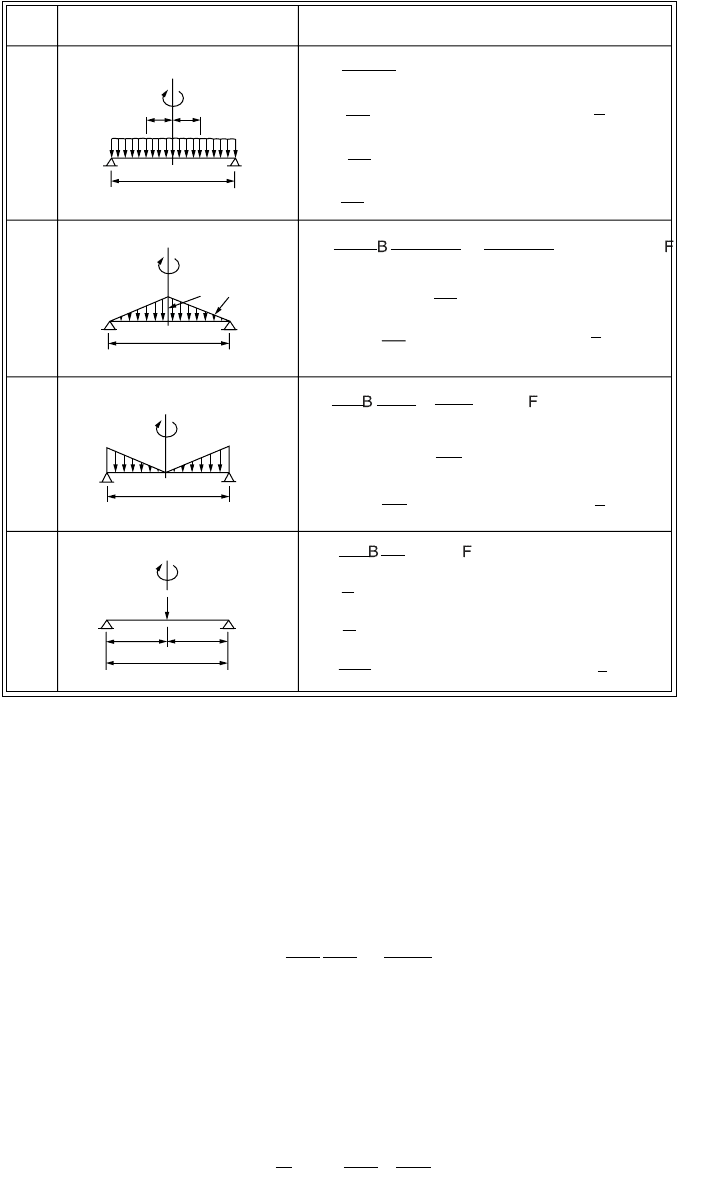
Theory and Analysis of Structures 47-51
can be calculated. The total potential energy is, therefore, given as V = U + W. Minimizing the total
potential energy, the plate problem can be solved.
The term is known as the Gaussian curvature.
If the function w(x, y) = f(x)f(y) (product of a function of x only and a function of y only) and w =
0 at the boundary are assumed, then the integral of the Gaussian curvature over the entire plate equals
zero. Under these conditions
FIGURE 47.38 Typical loading and boundary conditions for circular plates.
r
r
q
o
2r
o
q
o
q
o
2r
o
2r
o
q=q
o
(1 − ρ)
r
o
r
o
2r
o
P
1
2
3
4
Case
No.
Structural System and Static Loading Deflection and Internal Forces
w =
64D
q
o
(
r
1
o
+
4
ν)
[2(3 + ν) C
1
−(1 + ν) C
0
]
m
r
=
q
o
1
r
6
o
2
(3 + ν) c
1
m
θ
=
q
o
1
r
6
o
2
[2(1− ν) − (1+ 3ν) C
1
]
q
r
=
q
o
2
r
o
ρ
C
o
= 1− ρ
4
C
1
= 1 − ρ
2
C
1
= 1 − ρ
2
C
2
= ρ
2
nρ
C
3
= nρ
ρ
=
r
r
o
(m
r
)
ρ=0
= (m
ϕ
)
ρ =o
=
q
o
4
r
5
o
2
(4 + ν);
(q
r
)
ρ=1
= −
q
o
3
r
o
ρ =
r
r
o
m
r
=
4
P
π
(1 + ν) C
3
ρ =
r
r
o
(q
r
)
ρ=1
=
−
q
o
6
r
o
m
ϕ
=
4
P
π
[(1 − ν)− (1 + ν)C
3
]
w =
14
q
o
4
r
0
o
4
0D
3(183
1
+
+
ν
43ν)
−
10(71
1
+
+ν
29ν)
ρ
2
+225ρ
4
− 64ρ
5
(m
r
)
ρ=0
=
(m
ϕ
)
ρ = 0
=
q
7
o
2
r
4
o
0
(71 + 29ν);
w =
16
P
π
r
2
o
D
3
1+
+
ν
ν
C
1
+ 2C
2
q
r
=
2π
P
r
o
ρ
w =
4
q
o
5
r
0
o
4
D
3(
1
6
+
+
ν
ν)
−
5(
1
4
+
+
ν
ν)
ρ
2
+ 2ρ
5
ρ =
r
r
o
W,,=-
()()
ÚÚ
qxywxydxdy
area
22
2
2
2
ww
y
w
xy
∂
∂
∂
∂
-
∂
∂∂
Ê
Ë
Á
ˆ
¯
˜
È
Î
Í
Í
˘
˚
˙
˙
x
2
U
D
2
ww
y
dxdy
2
22
2
=
∂
∂
+
∂
∂
Ê
Ë
Á
ˆ
¯
˜
ÚÚ
x
area
2
© 2003 by CRC Press LLC
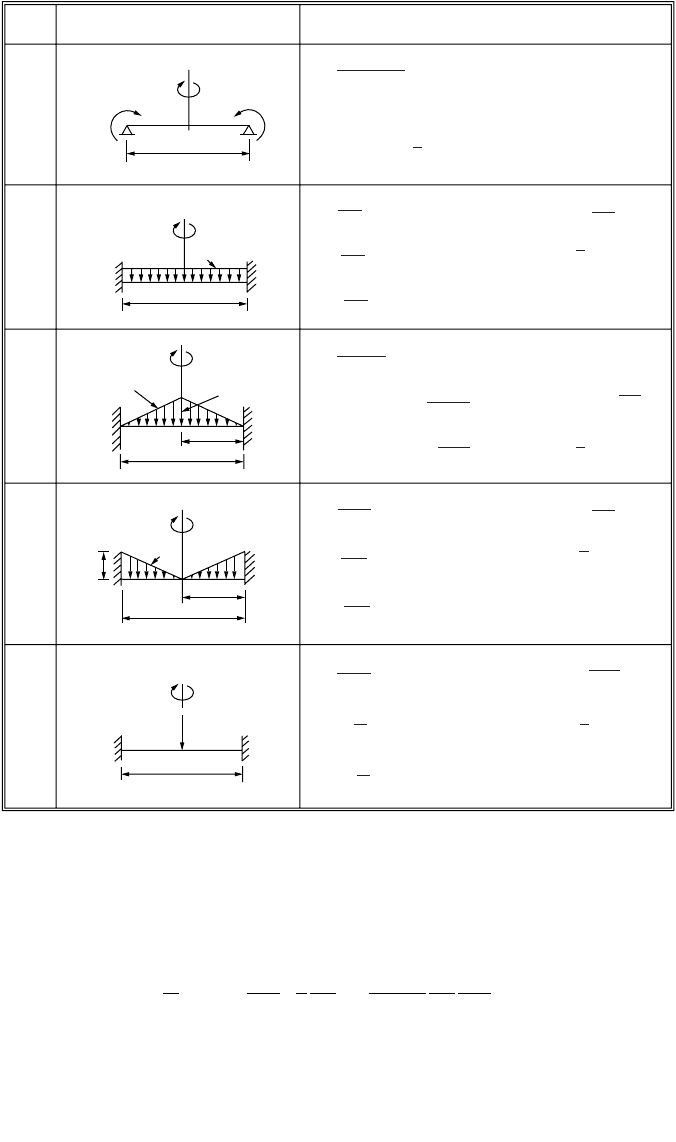
47-52 The Civil Engineering Handbook, Second Edition
If polar coordinates instead of rectangular coordinates are used and axial symmetry of loading and
deformation are assumed, the equation for strain energy, U, takes the form
(47.78)
and the work done, W, is written as
(47.79)
Detailed treatment of the plate theory can be found in Timoshenko and Woinowsky-Krieger (1959).
FIGURE 47.38 (continued).
6
5
7
8
9
Case
No.
Structural System and Static Loading Deflection and Internal Forces
M
M
2r
o
2r
o
q
o
q
o
q
o
r
o
q = q
o
(1 − ρ)
2r
o
2r
o
2r
o
q = ρq
o
r
o
P
q
r
= 0
m
r
= m
ϕ
= M
C
1
= 1 − ρ
2
,
ρ =
r
r
o
w =
2D(1
M
+
r
o
ν
2
)C
1
w =
q
6
o
4
r
D
o
4
(1 − ρ
2
)
2
m
r
=
q
1
o
r
6
o
2
[1 + ν − (3 + ν)ρ
2
]
m
ϕ
=
q
1
o
r
6
o
2
[1 + ν − (1+ 3ν)ρ
2
]
ρ =
r
r
o
q
r
= −
q
o
2
r
o
ρ
w =
14
q
4
o
0
r
o
4
0D
(129 − 290ρ
2
+ 225ρ
4
− 64ρ
5
)
(m
r
)
ρ=0
= (m
ϕ
)
ρ=0
=
2
7
9
2
q
o
0
r
o
2
(1 + ν)
(m
r
)
ρ=1
= (m
ϕ
)
ρ=1
= −
7
1
q
2
o
0
r
o
2
(q
r
)
ρ=1
= −
q
o
6
r
o
ρ =
r
r
o
ρ =
r
r
o
q
r
= −
q
o
3
r
o
ρ
2
ρ =
r
r
o
q
r
= −
2π
P
r
o
ρ
m
ϕ
= −
4
P
π
[ν + (1+ ν) n ρ]
m
r
= −
4
P
π
[1+ (1+ ν) n ρ]
w =
1
P
6π
r
o
2
D
(1 − ρ
2
+ 2ρ
2
n ρ)
m
ϕ
=
q
4
o
r
5
o
2
[1 + ν −(1+ 4ν)ρ
3
]
m
r
=
q
4
o
r
5
o
2
[1+ ν − (4 + ν)ρ
3
]
w =
4
q
5
o
0
r
o
4
D
(3 − 5ρ
2
+ 2ρ
5
)
U
Dw
rr
w
rr
w
r
w
r
rdrd
area
=+
Ê
Ë
Á
ˆ
¯
˜
-
-
()
Ï
Ì
Ô
Ó
Ô
¸
˝
Ô
˛
Ô
ÚÚ
2
1
21
2
2
2
2
2
∂
∂
∂
∂
n
∂
∂
∂
∂
q
W qwrdrd
area
=-
ÚÚ
q
© 2003 by CRC Press LLC
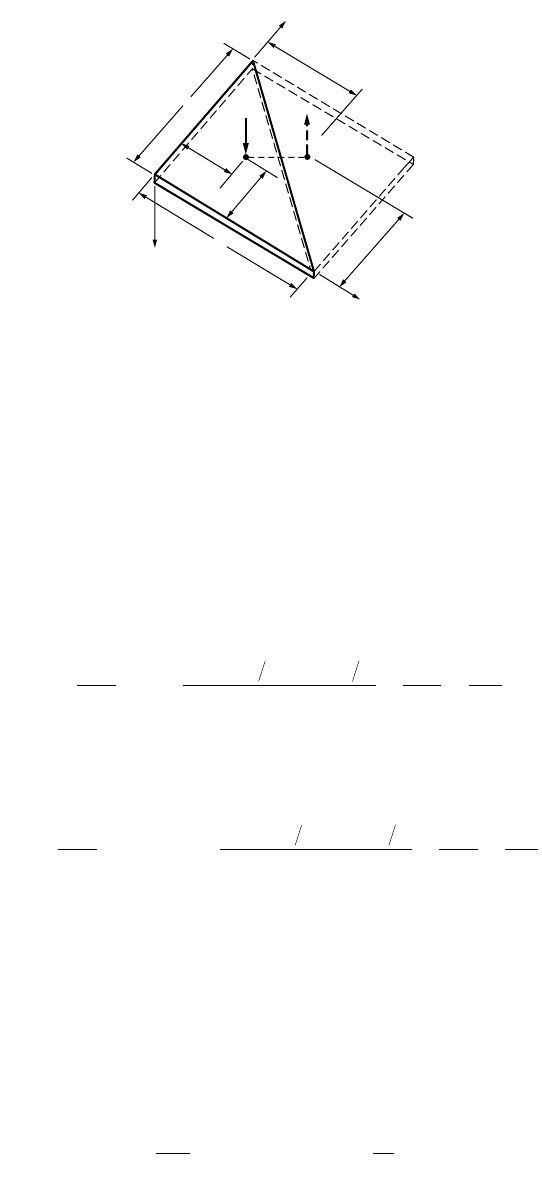
Theory and Analysis of Structures 47-53
Plates of Various Shapes and Boundary Conditions
Simply Supported Isosceles Triangular Plate Subjected to a Concentrated Load
Plates of shapes other than a circle or rectangle are used in some situations. A rigorous solution of the
deflection for a plate with a more complicated shape is likely to be very difficult. Consider, for example,
the bending of an isosceles triangular plate with simply supported edges under concentrated load P acting
at an arbitrary point (Fig. 47.39). A solution can be obtained for this plate by considering a mirror image
of the plate, as shown in the figure. The deflection of OBC of the square plate is identical with that of a
simply supported triangular plate OBC. The deflection owing to the force P can be written as
(47.80)
Upon substitution of –P for P, (a – y
1
) for x
1
, and (a – x
1
) for y
1
in Eq. (47.80), we obtain the deflection
due to the force –P at A
i
:
(47.81)
The deflection surface of the triangular plate is then
(47.82)
Equilateral Triangular Plates
The deflection surface of a simply supported plate loaded by uniform moment M
o
along its boundary,
and the surface of a uniformly loaded membrane, uniformly stretched over the same triangular boundary,
are identical. The deflection surface for such a case can be obtained as
(47.83)
FIGURE 47.39 Isosceles triangular plate.
y
B
PP
A
A
i
y
1
x
1
a − y
1
0
z
a
x
C
a − x
1
a
w
Pa
D
mxa ny a
mn
mx
a
ny
a
nm
1
2
4
11
22
2
11
4
=
()()
+
()
==
••
ÂÂ
p
pp
pp
sin sin
sin sin
w
Pa
D
mxa ny a
mn
mx
a
ny
a
mn
nm
2
2
4
11
22
2
11
4
1=- -
()
()()
+
()
+
==
••
ÂÂ
p
pp
pp
sin sin
sin sin
ww w=+
12
w
M
aD
xxyaxy a
o
=--+
()
+
È
Î
Í
˘
˚
˙
4
3
4
27
3222 3
© 2003 by CRC Press LLC
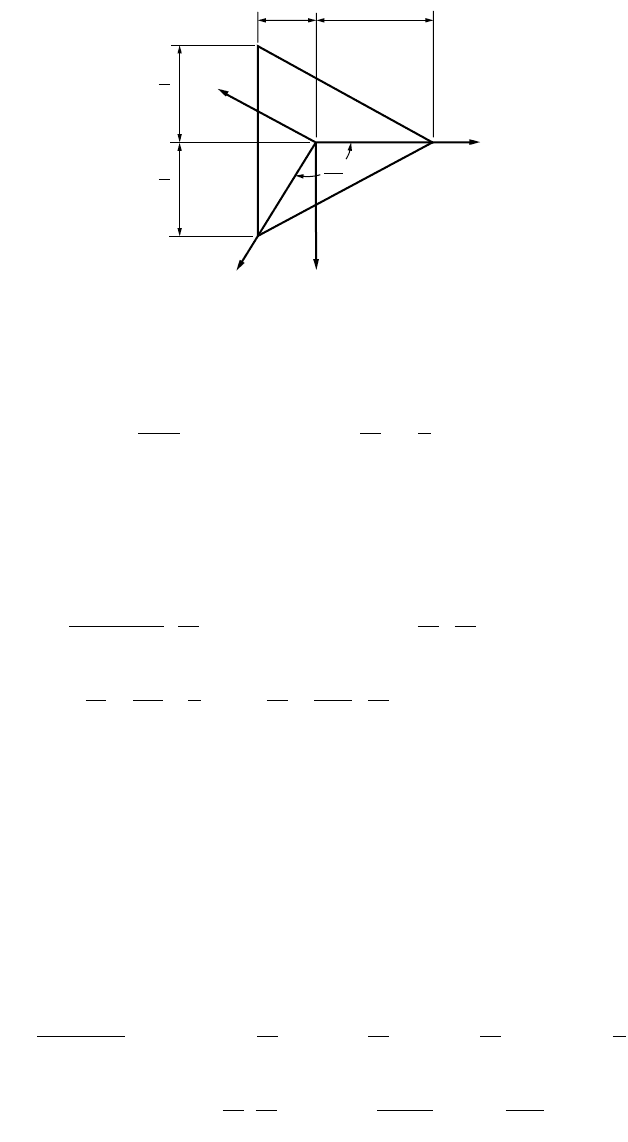
47-54 The Civil Engineering Handbook, Second Edition
If the simply supported plate is subjected to uniform load p
o
, the deflection surface takes the form
(47.84)
For the equilateral triangular plate (Fig. 47.40) subjected to a uniform load and supported at the corners,
approximate solutions based on the assumption that the total bending moment along each side of the
triangle vanishes were obtained by Vijakkhna et al. (1973), who derived the equation for the deflection
surface as
(47.85)
The errors introduced by the approximate boundary condition, i.e., the assumption that the total bending
moment along each side of the triangle vanishes, are not significant because the boundary condition’s
influence on the maximum deflection and stress resultants is small for practical design purposes. The
value of the twisting moment on the edge at the corner given by this solution is found to be exact.
The details of the mathematical treatment may be found in Vijakkhna et al. (1973, p. 123–128).
Rectangular Plate Supported at Corners
Approximate solutions for rectangular plates supported at the corners and subjected to a uniformly
distributed load were obtained by Lee and Ballesteros (1960). The approximate deflection surface is given
as
(47.86)
The details of the mathematical treatment may be found in Lee and Ballesteros (1960, p. 206–211).
FIGURE 47.40 Equilateral triangular plate with coordinate axes.
a/3
2a/3
η
x
y
a/√3
a/√3
2
3
π
ξ
w
p
aD
xxyaxy a axy
o
=--+
()
+
È
Î
Í
˘
˚
˙
--
Ê
Ë
Á
ˆ
¯
˜
64
3
4
27
4
9
3222 3222
w
qa
D
x
a
y
a
x
a
xy
a
x
a
xy
a
y
a
=
-
+
()
-
()
-+
()
-
()
+
Ê
Ë
Á
ˆ
¯
˜
--
()
+
()
È
Î
Í
Í
-
Ê
Ë
Á
ˆ
¯
˜
+-
()
++
Ê
Ë
Á
ˆ
¯
˜
˘
˚
˙
˙
4
2
22
2
3
3
2
3
2
4
4
22
4
4
4
144 1
8
27
72 71 51
3
9
4
12
()n
nn nn nn
n
w
qa
D
b
a
b
a
b
a
x
a
b
a
y
a
=
-
+-
()
+
Ê
Ë
Á
ˆ
¯
˜
--
()
++
()
-+-
()
Ê
Ë
Á
ˆ
¯
˜
È
Î
Í
Í
++
()
-+-
()
Ê
Ë
Á
ˆ
¯
˜
++-
()
4
2
2
4
4
2
2
2
2
2
2
2
2
2
2
2
48 1
10 1 2 7 1 2 1 5 6
215 6 2
()n
nn n n nn
nnn nn
xxy
a
xy
a
44
4
22
4
61
+
-+
()
˘
˚
˙
˙
n
© 2003 by CRC Press LLC
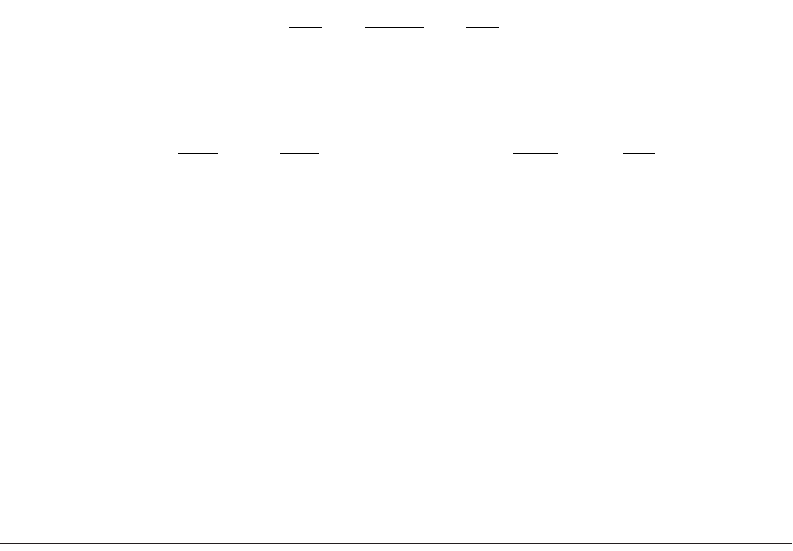
Theory and Analysis of Structures 47-55
Orthotropic Plates
Plates of anisotropic materials have important applications owing to their exceptionally high bending
stiffness. A nonisotropic or anisotropic material displays direction-dependent properties. Simplest among
them are those in which the material properties differ in two mutually perpendicular directions. A
material so described is orthotropic, e.g., wood. A number of manufactured materials are approximated
as orthotropic. Examples include corrugated and rolled metal sheets, fillers in sandwich plate construc-
tion, plywood, fiber reinforced composites, reinforced concrete, and gridwork. The latter consists of two
systems of equally spaced parallel ribs (beams), mutually perpendicular and attached rigidly at the points
of intersection.
The governing equation for orthotropic plates, similar to that of isotropic plates Eq. (47.86), takes the
form
(47.87)
in which
The expressions for D
x
, D
y
, D
xy
, and G
xy
represent the flexural rigidities and the torsional rigidity of an
orthotropic plate, respectively. E
x
, E
y
, and G are the orthotropic plate moduli. Practical considerations
often lead to assumptions, with regard to material properties, resulting in approximate expressions for
elastic constants. The accuracy of these approximations is generally the most significant factor in the
orthotropic plate problem. Approximate rigidities for some cases that are commonly encountered in
practice are given in Fig. 47.41.
General solution procedures applicable to the case of isotropic plates are equally applicable to ortho-
tropic plates. Deflections and stress resultants can thus be obtained for orthotropic plates of different
shapes with different support and loading conditions. These problems have been researched extensively,
and solutions concerning plates of various shapes under different boundary and loading conditions may
be found in the references viz. Tsai and Cheron (1968), Timoshenko and Woinowsky-Krieger (1959),
Lee et al. (1971), and Shanmugam et al. (1988 and 1989).
47.6 Shells
Stress Resultants in Shell Element
A thin shell is defined as a shell with a relatively small thickness, compared with its other dimensions.
The primary difference between a shell and a plate is that the former has a curvature in the unstressed
state, whereas the latter is assumed to be initially flat. The presence of initial curvature is of little
consequence as far as flexural behavior is concerned. The membrane behavior, however, is affected
significantly by the curvature. Membrane action in a surface is caused by in-plane forces. These forces
may be primary forces caused by applied edge loads or edge deformations, or they may be secondary
forces resulting from flexural deformations.
In the case of the flat plates, secondary in-plane forces do not give rise to appreciable membrane action
unless the bending deformations are large. Membrane action due to secondary forces is, therefore,
neglected in small deflection theory. In the case of a shell which has an initial curvature, membrane
action caused by secondary in-plane forces will be significant regardless of the magnitude of the bending
deformations.
D
w
x
H
w
xy
D
w
y
q
xy
d
d
d
dd
d
d
4
4
4
22
4
4
2++=
D
hE
D
hE
HD G D
hE
G
hG
x
x
y
y
xy xy xy
xy
xy
===+= =
3
33
3
12 12
2
12 12
,, , ,
© 2003 by CRC Press LLC

47-56 The Civil Engineering Handbook, Second Edition
A plate is likened to a two-dimensional beam and resists transverse loads by two-dimensional bending
and shear. A membrane is likened to a two-dimensional equivalent of the cable and resists loads through
tensile stresses. Imagine a membrane with large deflections (Fig. 47.42a), reverse the load and the mem-
brane, and we have the structural shell (Fig. 47.42b), provided that the shell is stable for the type of load
shown. The membrane resists the load through tensile stresses, but the ideal thin shell must be capable
of developing both tension and compression.
FIGURE 47.41 Various orthotropic plates.
t
s
x
y
z
s
s
h
t
t
1
s
t
h
h sin
πx
s
Geometry
Rigidities
A. Reinforced concrete slab with x and y
directed reinforcement steel bars
B. Plate reinforced by equidistant
stiffeners
C. Plate reinforced by a set of equidistant
ribs
D. Corrugated plate
n
c
: Poisson's ratio for concrete
E
c
, E
s
: Elastic modulus of concrete and steel, respectively
I
cx
(I
sx
), I
cy
(I
sy
): Moment of ineretia of the slab (steel bars) about
neutral axis in the section x = constant and
y = constant, respectively
E, E′ : Elastic modulus of plating and stiffeners, respectively
n : Poisson’s ratio of plating
s : Spacing between centerlines of stiffeners
I : Moment of inertia of the stiffener cross section with respect to
midplane of plating
C : Torsional rigidity of one rib
I : Moment of inertia about neutral axis of a T-section of width s
(shown as shaded)
G′
xy
: Torsional rigidity of the plating
E : Elastic modulus of the plating
where
D
x
=
E
c
1− ν
c
2
I
cx
+
E
E
s
c
− 1 I
sx
D
y
=
E
c
1 − ν
2
c
Icy +
E
E
s
c
−1 I
sy
G
xy
=
2
1 −
ν
c
D
x
D
y
D
x
D
y
H
=
D
x
D
y
D
xy
= ν
c
D
y
=
12(1− ν
2
)
D
x
= H =
12(1− ν
2
)
Et
3
Et
3
+
E
s
′I
D
x
=
Est
3
12[s − h + h (t t
1
)
3
]
D
y
=
E
s
I
D
xy
= 0
H = 2G′
xy
+
C
s
D
x
=
s
λ
Et
3
12(1 − ν
2
)
D
y
= EI, H =
λ
a
Et
3
12(1 + ν)
D
xy
= 0
λ = s 1 +
π
4s
2
2
h
2
I = 0.5h
2
t 1 −
1 + 2.5(h/2s)
2
0.81
© 2003 by CRC Press LLC
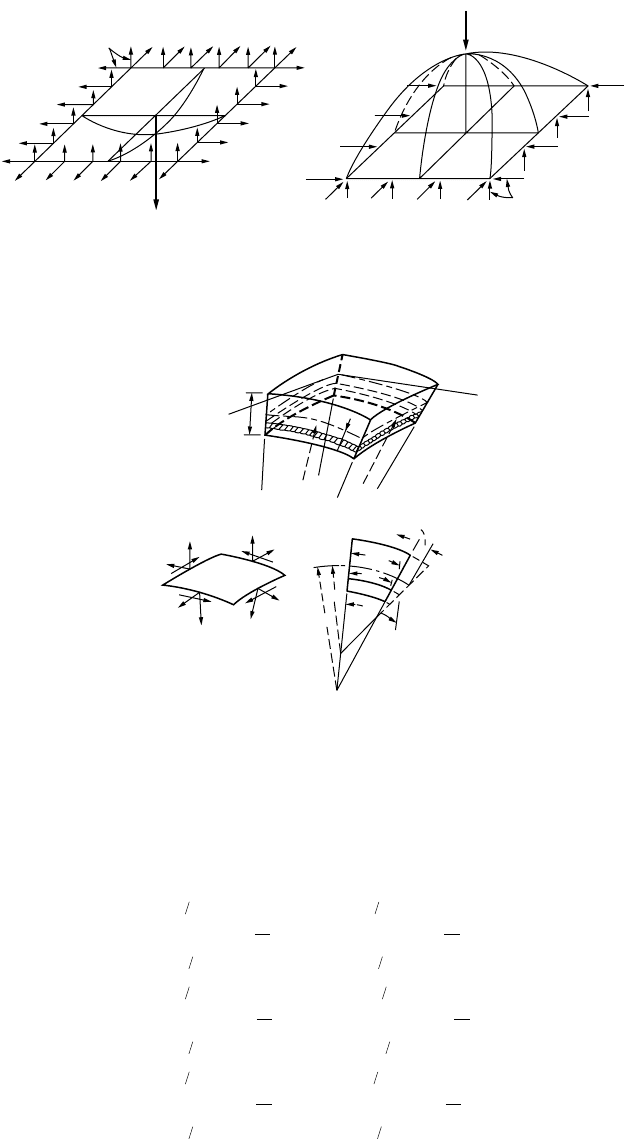
Theory and Analysis of Structures 47-57
Consider an infinitely small shell element formed by two pairs of adjacent planes that are normal to
the middle surface of the shell and contain its principal curvatures, as shown in Fig. 47.43a. The thickness
of the shell is denoted as h. Coordinate axes x and y are taken tangent at o to the lines of principal
curvature, and the axis z normal to the middle surface. r
x
and r
y
are the principal radii of curvature lying
in the xz and yz planes, respectively. The resultant forces per unit length of the normal sections are given as
(47.88)
The bending and twisting moments per unit length of the normal sections are given by
FIGURE 47.42
FIGURE 47.43 Shell element.
Load
Reactions
(b)
Reactions
Load
(a)
A
0
C
B
x
h
y
D
z
r′
x
r
x
r
y
r
x
(a)
Q
x
Q
y
N
xy
N
y
N
x
N
yx
0
(b)
(c)
ds
l
1
l
2
1
ds
N
z
r
dz N
z
r
dz
N
z
r
dz N
z
r
dz
Q
z
r
dz
xx
y
h
h
yy
x
h
h
xy xy
y
h
h
yx yx
x
h
h
xxz
y
h
=-
Ê
Ë
Á
ˆ
¯
˜
=-
Ê
Ë
Á
ˆ
¯
˜
=-
Ê
Ë
Á
ˆ
¯
˜
=-
Ê
Ë
Á
ˆ
¯
˜
=-
Ê
Ë
Á
ˆ
¯
˜
--
--
-
ÚÚ
ÚÚ
ss
tt
t
11
11
1
2
2
2
2
2
2
2
2
,
,
,
22
2
2
2
1
h
yyx
x
h
h
Q
z
r
dz
ÚÚ
=-
Ê
Ë
Á
ˆ
¯
˜
-
t
© 2003 by CRC Press LLC
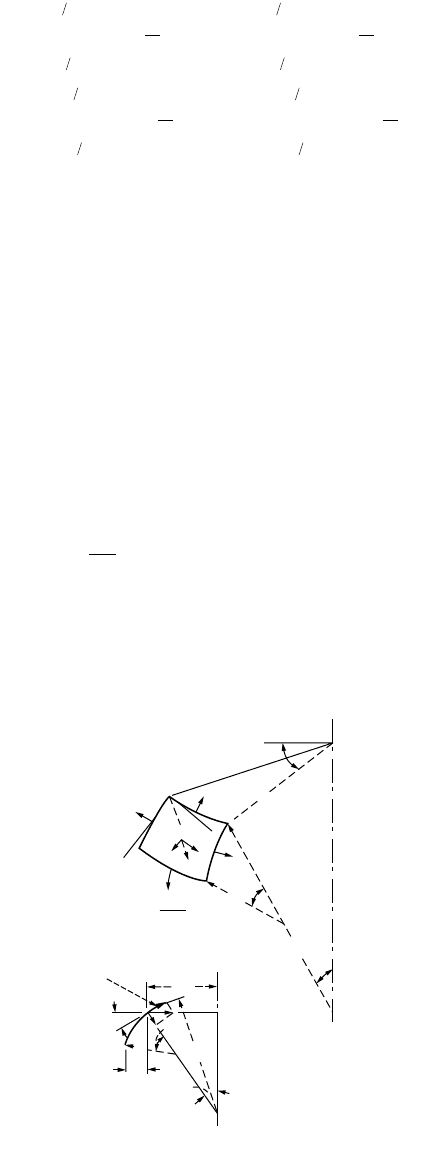
47-58 The Civil Engineering Handbook, Second Edition
(47.89)
It is assumed, in bending of the shell, that linear elements such as AD and BC (Fig. 47.43), which are
normal to the middle surface of the shell, remain straight and become normal to the deformed middle
surface of the shell. If the conditions of a shell are such that bending can be neglected, the problem of
stress analysis is greatly simplified, since the resultant moments (Eq. (47.89)) vanish along with shearing
forces Q
x
and Q
y
in Eq. (47.88). Thus the only unknowns are N
x
, N
y
, and N
xy
= N
yx
; these are called
membrane forces.
Shells of Revolution
Shells having the form of surfaces of revolution find extensive application in various kinds of containers,
tanks, and domes. Consider an element of a shell cut by two adjacent meridians and two parallel circles,
as shown in Fig. 47.44. There will be no shearing forces on the sides of the element because of the
symmetry of loading. By considering the equilibrium in the direction of the tangent to the meridian and
z, two equations of equilibrium are written, respectively, as
(47.90)
The forces N
q
and N
j
can be calculated from Eq. (47.90) if the radii r
0
and r
1
and the components Y and
Z of the intensity of the external load are given.
FIGURE 47.44 Element from shells of revolution — symmetrical loading.
MZ
z
r
dz M Z
z
r
dz
MZ
z
r
dz M Z
z
r
dz
xx
y
h
h
yy
x
h
h
xy xy
y
h
h
yx yx
x
h
h
=-
Ê
Ë
Á
ˆ
¯
˜
=-
Ê
Ë
Á
ˆ
¯
˜
=- -
Ê
Ë
Á
ˆ
¯
˜
=-
Ê
Ë
Á
ˆ
¯
˜
--
--
ÚÚ
ÚÚ
ss
ts
11
11
2
2
2
2
2
2
2
2
,
,
d
d
Nr Nr
cos Y
rr
0
Nr Nr
sin Z
rr
0
01 10
01 10
j
f
j
jq
jq
()
-+=
++=
θ
N
θ
N
θ
dθ
N
ϕ
δϕ
N
ϕ
+
δ
N
ϕ
dϕ
dϕ
d
ϕ
dr
o
ϕ
r
o
r
1
r
o
r
2
r
1
r
2
0
z
Z
Y
y
X
x
(a)
N
θ
r
1
cosϕ dϕ dθ
ϕ
ϕ
(b)
© 2003 by CRC Press LLC

Theory and Analysis of Structures 47-59
Spherical Dome
The spherical shell shown in Fig. 47.45 is assumed to be subjected to its own weight; the intensity of the
self weight is assumed as a constant value, q
o
, per unit area. Considering an element of the shell at an
angle j, the self weight of the portion of the shell above this element is obtained as
Considering the equilibrium of the portion of the shell above the parallel circle, defined by the angle j,
we can write,
(47.91)
Therefore,
We can write from Eq. (47.90)
(47.92)
substituting for N
j
and z = R in Eq. (47.92)
It is seen that the forces N
f
are always negative. There is thus a compression along the meridians that
increases as the angle j increases. The forces N
q
are also negative for small angles j. The stresses as
calculated above will represent the actual stresses in the shell with great accuracy if the supports are of
such a type that the reactions are tangent to the meridians, as shown in Figure 47.45.
Conical Shells
If a force P is applied in the direction of the axis of the cone, as shown in Fig. 47.46, the stress distribution
is symmetrical and we obtain
FIGURE 47.45 Spherical dome.
r
o
a
ϕ
α
R =
=-
()
Ú
2
a
q
sin d
2
a
q
1 cos
0
2
0
2
0
pjj
pj
f
2
N
sin R 0pj
j
r
o
+=
j
j
jj
N
aq 1 cos
sin
aq
1 cos
2
=-
-
()
=-
+
o
o
j
q
N
r
N
r
Z
12
+=-
q
j
j
N
aq
1
1 cos
cos=-
+
-
Ê
Ë
Á
ˆ
¯
˜
o
© 2003 by CRC Press LLC
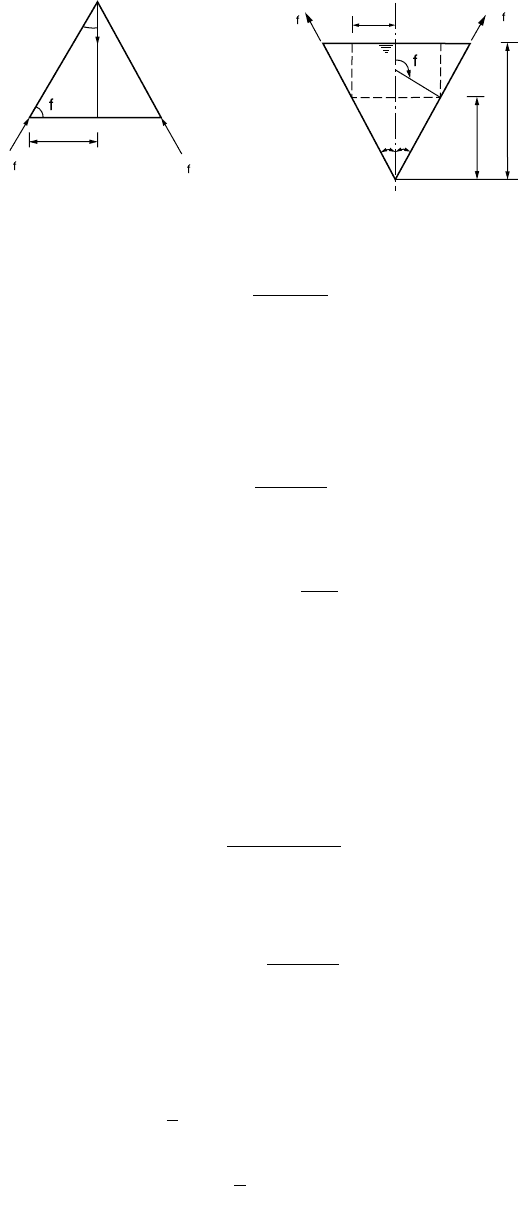
47-60 The Civil Engineering Handbook, Second Edition
By Eq. (47.92), one obtains N
q
= 0.
In the case of a conical surface in which the lateral forces are symmetrically distributed, the membrane
stresses can be obtained by using Eqs. (47.91) and (47.92). The curvature of the meridian in the case of
a cone is zero, and hence r
1
= •; Eqs. (47.91) and (47.92) can therefore be written as
and
If the load distribution is given, N
f
and N
q
can be calculated independently.
For example, a conical tank filled with a liquid of specific weight g is considered in Fig. 47.47. The
pressure at any parallel circle mn is
p = –Z = g(d – y)
For the tank, f = a + (p/2) and r
0
= y tana. Therefore,
N
q
is maximum when y = d/2 and hence
The term R in the expression for N
f
is equal to the weight of the liquid in the conical part mno, and
the cylindrical part must be as shown in Fig. 47.46. Therefore,
FIGURE 47.46 Conical shell. FIGURE 47.47 Inverted conical tank.
P
α
r
o
N
N
N
N
s
y
d
t
m
0
r
o
r
2
α α
n
f
pa
N
P
2 cos
=-
r
0
f
pf
N
R
2 sin
=-
r
0
q
f
N
Z
Z
sin
=- =-r
r
2
0
q
ga
a
N
dyy tan
cos
=
-
()
N
q
ga
a
()
=
max
2
d
tan
4cos
R
1
3
y
tan
y
tan
dy
y
d
2
3
y
tan
3
2
2
2
2
2
=- + -
()
È
Î
Í
˘
˚
˙
=- -
Ê
Ë
Á
ˆ
¯
˜
papa g
pg a
© 2003 by CRC Press LLC
